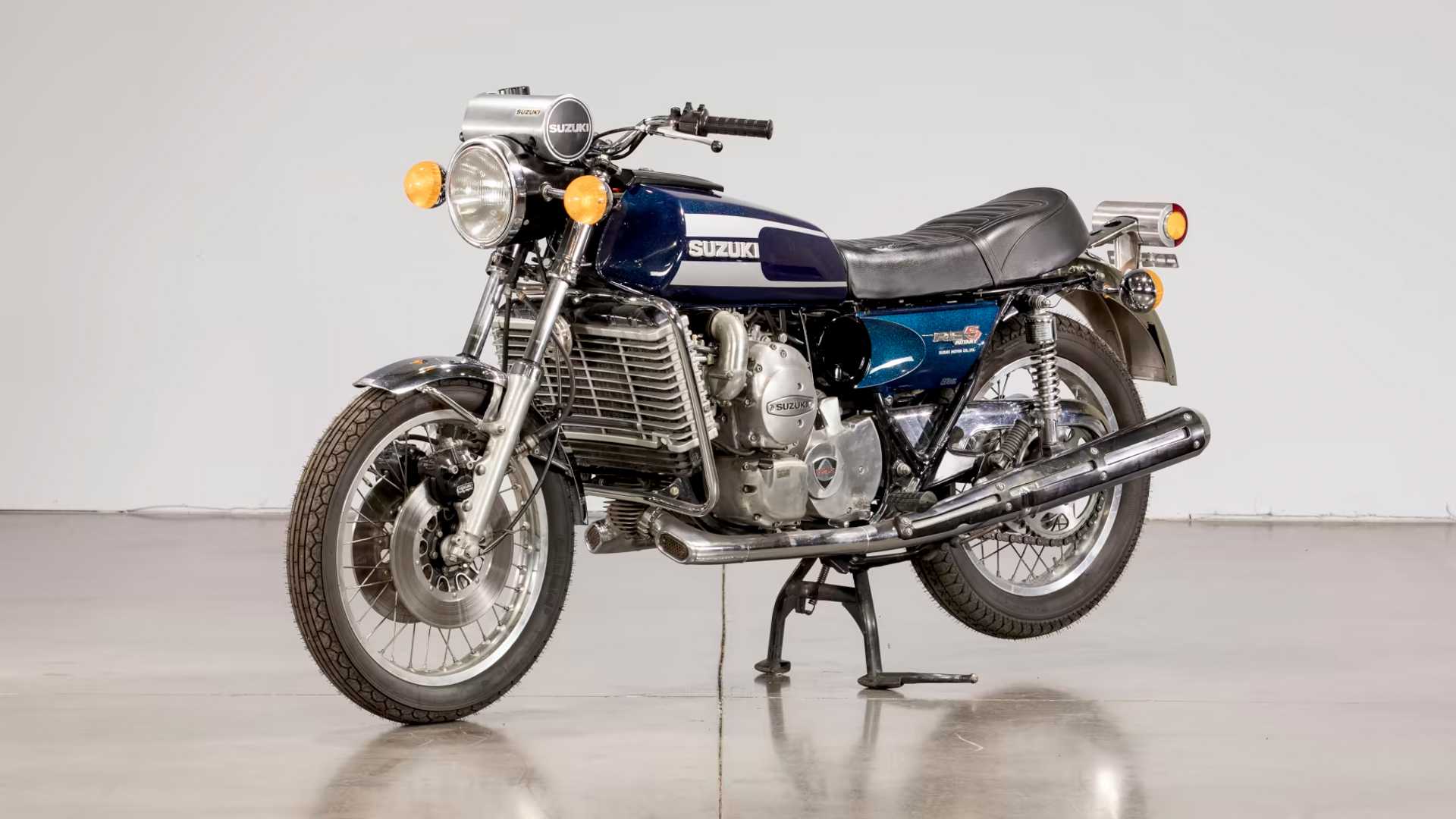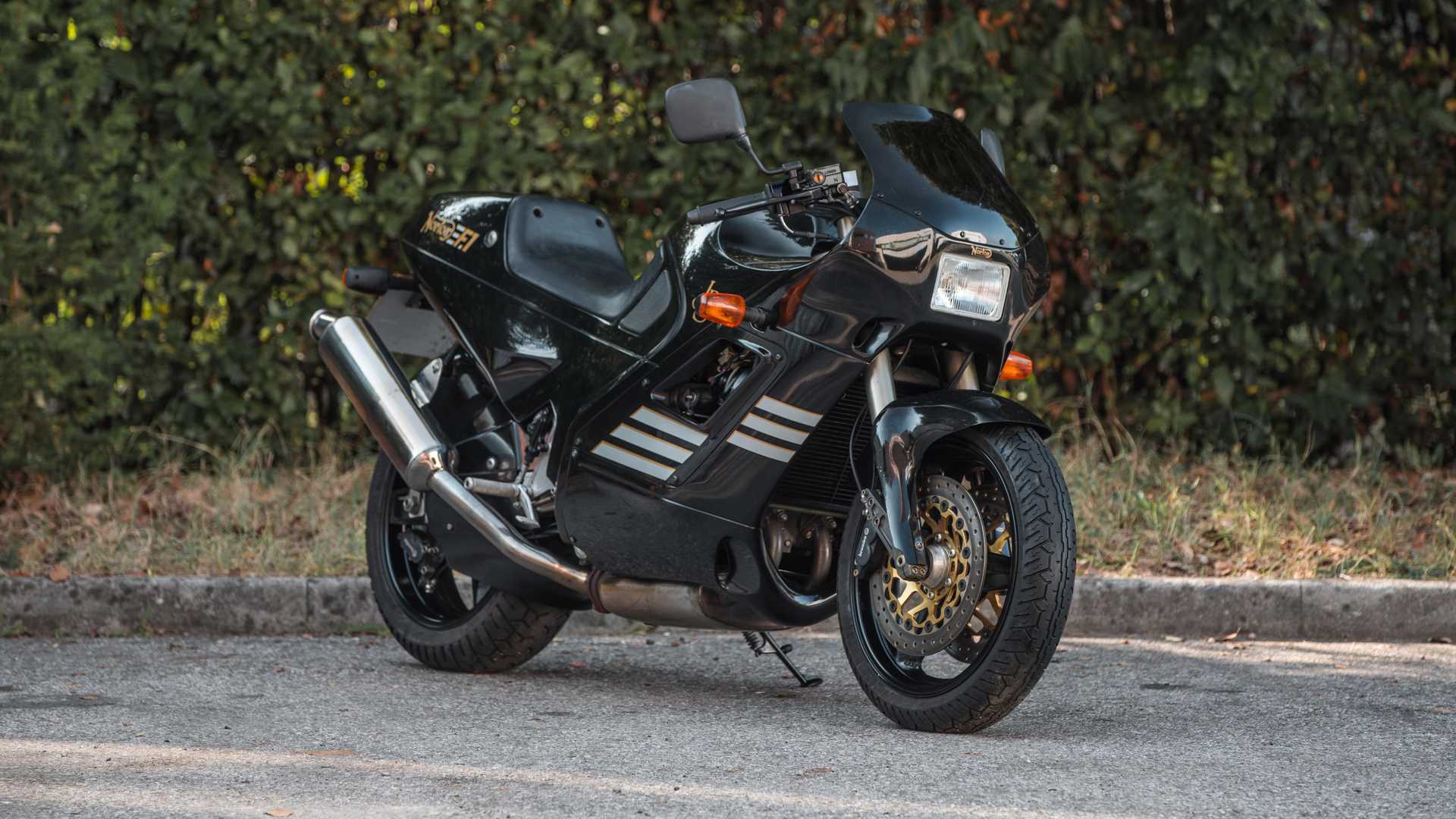After NSU’s first forays into rotary power with the Wankel-Spider and the Ro-80 sedan in the 1960s, Mazda licensed the technology for use in its own cars. When the engine found its way into the Cosmo Sport , the world finally got a taste of reliable rotary power for the masses. From that point, Mazda continued to improve on its efforts, and it wasn’t until 2012 that it finally pulled the plug on the engine design due to emissions regulations.
It’s worth noting that Mazda wasn’t the only Japanese brand to license the Wankel engine in the 1960s. In fact, a number of motorcycle manufacturers experimented with the technology in an effort to revolutionize two-wheeled transport. Ultimately, however, only Suzuki brought its design to production. What resulted was unlike anything else, as it offered smooth, linear power delivery and an unusual engine sound. The bike was packed with potential, but it faded out of existence after just two years on the market. Read on to see why we think it’s worth remembering.
The RE5 Aimed To Revolutionize Two Wheels

By the mid-1970s, the Universal Japanese Motorcycle (UJM) designs that had come to dominate the industry were beginning to grow stale, and manufacturers needed a way to differentiate themselves from the competition. While there were any number of off-beat innovations that came about during the time, like Kawasaki’s pioneering forced induction efforts or Honda’s automatic transmission, few bikes boast the same ingenuity of the Suzuki RE5 . Though each of the Big Four supposedly dabbled with rotary applications (Yamaha even created a functional concept), Suzuki was the only manufacturer daring enough to put it into production. Powered by an NSU-developed Wankel engine and penned by Giorgetto Giugiaro, the RE5 was as much a mechanical experiment as it was a stylistic statement.
Bucking The Norm With Wankel Power
Easily the most defining feature of the Suzuki RE5 had to be its Wankel engine. Rather than incorporating reciprocating pistons typical of a traditional internal combustion engine, Suzuki instead licensed a design from NSU based around a single spinning rotor. Along with offering fewer components compared to other configurations of the day, this deisgn also promised smoother operation. Many motorcycles were plagued by reliability issues due to their mechanical complexity and operational vibration, so Suzuki hoped that the RE5 would be something that was not only more reliable but also more refined.
While the engine itself boasted fewer moving parts, the systems required for its operation proved to be much more involved. For instance, because exhaust temperatures could climb as high as 1,700 degrees Fahrenheit, the engine struggled with cooling. Suzuki utilized three separate oil pumps throughout the bike, also incorporating water cooling for the engine cases and oil cooling for the combustion chamber through a series of radiators mounted behind the forks. Moreover, the two-stage Mikuni carburetor relied on five different fuel and air circuits to accommodate the high-revving rotor, and Suzuki had to incorporate special ignition mapping on account of the Wankel's minimal engine braking. Suffice to say, it was a tall order for the shade tree mechanic to keep an RE5 in running condition, and even trained technicians experienced growing pains because of the bike’s complex design.
A Design Intended To Stand Out
A model as innovative as the RE5 needed an appearance that would stand out, so Suzuki tapped legendary automotive designer Giorgetto Giugiaro to pen the bike's striking looks. Later made famous for cars like the Lotus Esprit and the DeLorean DMC-12 , Giugiaro gave the RE5 a distinctive forward-thinking style. Along with a large chromed radiator at the front, he also bestowed the bike with sculpted side panels and a unique cylindrical instrument cluster with an integrated cover. Come 1976, however, the hood design was ditched in favor of a more traditional gauge arrangement.
While the overall package wasn't dissimilar to other naked motorcycles of the era, the RE5's rotary engine was unlike anything on the market—in its performance and its appearance. Unfortunately, however, the bike's radical engineering didn't attract buyers . Among a sea of more conservative twins and inline-fours, the Wankel-powered Suzuki was something foreign and unproven. Though Suzuki offered to replace the engine within the first year in the event of any problems, the rotary had developed a reputation based on a few isolated incidents, and many potential buyers were skeptical of the pay-off.
How Suzuki’s Rotary Fared Against Its Rivals
When the Suzuki RE5 hit the market in 1975, the bike was praised for its mid-range torque and unparalleled smoothness. In a period rotary engine pro and con piece, Cycle World stated that, "on winding roads, the RE5 will surprise you" on account of the fact that the Suzuki "has the right kind of power for coming out of corners with the gas all the way on." Moreover, testers noted that "out on the highway, there is simply nothing that can equal its lack of vibration," even going so far as to state "for that reason alone, the rotary Suzuki must be rated one of the most promising designs to reach motorcycle production in quite some time." Suffice to say, then, that for all of it controversy, the RE5 did make an impact with the press.
1975 Suzuki RE5 And Period Competition Performance Specs
BMW, Honda, Kawasaki, Suzuki
For all the bike's promise, ultimately, the performance couldn't justify the rotary engine's complications. Between the extra heft resulting from the additional cooling equipment and the unimpressive 110-mph top speed, many motorcyclists couldn't see the appeal of the Wankel design. In trying to buck the norm, Suzuki had gambled big, but the RE5 was nevertheless a slow seller. Over the course of its two-year production, just 6,350 examples rolled off the line. 10 years after it was discontinued, Cycle World declared it one of "The Ten Worst Motorcycles."
Suzuki RE5 Production Stats
- Years in production: 1974-1976
- Total produced: ~6,350
- Original MSRP: $2,945
What A Suzuki RE5 Will Run You Today

If you're not put off by the complications that come with a rotary powerplant, the good news is that the Suzuki RE5 can be had for attainable prices on the secondhand market. Many vintage Japanese motorcycles are currently experiencing a surge in value, but the RE5's niche appeal means that the pool of potential buyers is smaller than that of other more traditional bikes. As such, Hagerty's Price Tool puts a 'Good' condition RE5 at $6,900, and even the nicest 'Concours' examples should only set you back some $13,600. For perspective, an 'Excellent' condition 1975 Honda CB750 is valued at $12,000, but 'Concours' bikes can soar as high as $21,000.
1975-1976 Suzuki RE5 Valuations
Hagerty
Even when you look at completed transactions, the RE5 proves a pretty reasonable buy. Over the course of 13 sales on Bring a Trailer, Suzuki's rotary motorcycle averaged $8,379.15 at auction. Though that puts it above the median result of $6,850, the highest-selling RE5 went for nearly double the average sale at $16,650. Moreover, you'll find that several examples have been sold for less, as there have been multiple sales falling around the $6,000 mark. It is worth noting, however, that Bring a Trailer's lowest recorded auction closing at $3,750 resulted in a no-sale.
1975-1976 Suzuki RE5 Past Sales
- Low Sale: $6,000
- Average Sale: $8,764.92
- Median Sale: $7,484.50
- High Sale: $16,650
In the event that you do find yourself shopping for an RE5, be sure to source the lowest-mileage example you can afford. Rotary specialists are few and far between, and parts are harder to find still, so you'll save yourself some pretty significant headaches if the previous owner has managed to stay up to date on their maintenance.
Suzuki Wasn't Alone In Its Wankel Efforts

Although the RE5 makes for one of the most well-known examples of rotary motorcycles, Suzuki was far from the only brand to experiment with the Wankel engine in two-wheeled applications. Over in the UK, Norton also broke away from its more traditional twins in order to explore the viability of rotary power. The British manufacturer’s efforts initially began in the late 1960s and by the 1980s and early 1990s, it had created a series of production bikes powered by Wankel rotors.
Norton Rotary Motorcycles Specs Comparison
Norton
Norton kicked things off with the release of the Classic in 1987, building a 100-unit run of its rotary-powered naked. Though the bike’s frame was outdated compared to the advanced designs coming from Japan, it was meant as more of a neo-retro tribute than an all-out performance model. Nevertheless, Norton continued to improve on its efforts—first in the form of a sport touring bike known as the Commander and subsequently through a full-faired competition-derived sportbike called the F1 .
On the track, Norton’s successful John Player Special team proved the rotary’s race potential with wins at the Isle of Man TT and multiple British titles. In the end, however, the engine suffered from heat management issues and expensive operating costs. Still, Norton proved that Suzuki wasn’t alone in betting on Wankel engineering, and that, under the right conditions, a rotary could be made to truly shine.
Sources: Audrain , Cycle World , Hagerty , National Motorcycle Museum